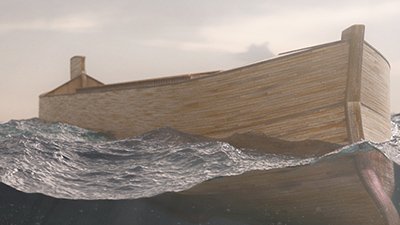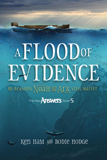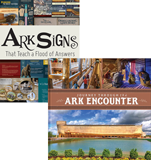The Ark and the Apocalypse–An Intriguing Connection
Introduction
A few months ago, I was interviewed by a Netflix crew from New Zealand whose stated premise was a documentary about “large” attractions in the United States. It made a lot of sense that they wanted to feature the Ark Encounter, but as the interview progressed, I realized that maybe their documentary had a different focus. The young man who interviewed me seemed fixated on asking questions about the end times. He saw a very clear connection between the past judgment by God on people in Noah’s day and was concerned if and when a future judgment by God was coming. It was definitely not a typical interview about the Ark! When they told me their next destination was visiting “preppers” in North Carolina, I surmised the real purpose of their documentary was an apocalyptic one.
Although the interview was strange, I recently became aware of a journal article on the very same topic. The article by Emma Frances Bloomfield was titled, “Ark Encounter as Material Apocalyptic Rhetoric: Contemporary Creationist Strategies On Board Noah’s Ark” and was featured in the Southern Communication Journal.1 Now my curiosity was really piqued. I began to wonder if the Netflix crew had read the article, as it would have been perfect background material for their documentary.
We can and should help unbelievers see the connection between these two judgments so that we might more effectively share the gospel of Jesus Christ.
The Ark Encounter has always been about helping people understand the reality of the Ark and Flood so that they might trust that God’s Word is true and authoritative. While these unbelievers saw that, they also saw something much more. If Scripture was true about a past judgment by God, then it was also true about a future judgment by him. It’s easy to gloss over these apocalyptic fears as Christians because we know our final destination. But we can and should help unbelievers see the connection between these two judgments so that we might more effectively share the gospel of Jesus Christ.
Is the Ark an “Apocalyptic Argument”?
The thesis of Bloomfield’s paper was very clear:
The AE [Ark Encounter] is an embodiment of the apocalyptic genre, containing linguistic, visual, and material elements that elicit fear in its visitors through constructing a palpable “tension” between danger and safety. To secure their safety, visitors are compelled to agree with the AE’s arguments, lest they face the dangerous world outside of the ark where chaos, secularism, and evolutionary thinking flourish.
In following paragraphs, she uses terminology like “imminent damnation” and “imminent dangers” to further support her perceived idea that if you don’t believe the information presented at the Ark, you are going to hell. At AiG we have stated many times that a belief in the biblical account of Creation and the Flood are not necessary for salvation. Scripture is clear that if you confess your sin and believe in the atoning work of Jesus Christ, you will be saved (John 10:9; Romans 10:9). However, one of the major stumbling blocks to the gospel can be a disbelief in Genesis. If Genesis isn’t true, which provides the foundational history for the gospel, then why believe the gospel rooted in that history is true?
The author discusses three “topoi” or themes that Ark Encounter presents to “construct a strong apocalyptic argument.” While I think most of her points are valid and reasonable, others seem to force her apocalyptic views onto things that were not really designed with that intention.
“Authority of the Bible”
I was glad to see that this was the first theme because it is a core focus of the Answers in Genesis ministry. She was very complimentary toward the Ark, as she wrote at length about it being an immersive experience that is felt and heard and how this lends to the feasibility and authenticity of the Ark. Bloomfield states,
Belief in the AE affords authority to the story of Noah’s ark, which subsequently serves as a powerful synecdoche [a figure of speech by which a part is put for the whole] for the veracity of the Bible as a whole. . . .
The AE provides evidence that what may seem like an impossible feat was an achievable one. If Noah’s ark could have housed many animals and safely navigated the rough waters as communicated in the Bible, then the Bible is the ultimate authority over the past.
Yes, exactly, and I’m glad that even as an unbeliever she could see this so clearly. I wish Christians would understand this connection as well as she does!
Bloomfield even thinks the pathways that lead people through the Ark are intentionally apocalyptic. “Similar to Noah’s obligation to follow God’s orders, the Ark Encounter’s visitors are obligated to follow the one route to salvation. Visitors are stuck on a path.” Actually, it was just the most practical way to move people through the Ark. Possibly Noah had a similar system of ramps throughout the Ark, which would be a much easier way to get around than stairs. Furthermore, visitors are not really obligated to follow one path in the Ark. They can choose to see the exhibits in any order they would like, but there is a thematic and logical flow to the most natural “path” through the Ark.
She concludes this section with this bold proclamation:
The AE argues that the Bible has authority over the truth and thus should be trusted on all matters within its pages. If Noah’s story is true, the rest of the Bible, including passages about the return of Jesus to Earth and the next global judgment before the apocalypse, are infused with accuracy and truth.
The Bible can be trusted about a past judgment and a future one.
Agreed! Although she uses the word story (which often refers to something fictitious, especially to children), Noah, the Flood, and Ark are all part of a true account from history. The Bible can be trusted about a past judgment and a future one.
“Evil Threats to Christianity”
The second theme focuses on comparing the perceived safety of the Ark to the evil of the world outside the Ark. Bloomfield states,
The AE identifies many enemies to Christianity: those who distort the Bible, those who doubt the Bible, and those who commit sins. The AE offers that only through Christianity, as represented on the AE, can visitors protect themselves from the figurative, but imminent, flood waters.
In reality, everyone (whether inside or outside the Ark) is a sinner, and, when they sin, they behave as an enemy of Christianity. Genesis 6:9 says that Noah was righteous man, but we also know from Genesis 9:21 that he was still a sinner. The Christianity represented on the Ark is the gospel found in the Bible. Noah and his family and the animals entered through one door on the Ark to be spared from the physical consequences of the Flood. Similarly, there is only one way to God the Father and that is through the “door” of his Son Jesus Christ (John 10:9)
Bloomfield then argues that Ark Encounter views scientists as one of those evil threats.
In a display titled, “Denying the biblical flood: Science or bias?” the AE argues that “nearly every geologist would appeal to a global flood to explain many of Earth’s features if the Bible had never mentioned such an event.” This statement paints evolutionists, scientists, and geologists as purposefully undermining the history of the Bible due to personal biases. Along with displays that doubt human’s ability to influence the Earth’s climate, the AE blames dissenting voices and distortions of the Bible’s teachings for misinformation about the Bible and thus its rejection as an authority over the past.
What she needs to realize is that everyone has a bias or a worldview by which they look at and understand the world. There are only two choices: man’s word or God’s Word. Many scientists don’t have a biblical worldview because they fail to investigate scientific claims for themselves and believe the Bible has been disproven. They try to understand the past based on their own ideas rather than the eyewitness accounts given to us in God’s Word. Even many Christians have become infected with this way of thinking, leading them to discount the biblical accounts of Creation and the Flood. Sadly, this is a slippery slope that leads to a disbelief in the Bible as an authority in many other areas as well such as the definition of marriage, the sanctity of life, and even the gospel.
The author then makes a partly true but partly strange statement:
The AE directly compares the evils from the pre-flood world to the sins of the present on two sides of a narrow hallway. Titled, “Descent into Darkness,” the pre-flood sins listed include the expected sins of polygamy and violence, as well as the more surprising transgressions of music and metalworking.
It’s true that many of the sins that were occurring in Noah’s day are occurring in our present world. Our intention was to link the past to the present. If God judged those sins in the past, then he is going to judge those sins at some point in the future. However, we are not inferring that music and metalworking are sins. We are simply stating that during the time that world was becoming more sinful, the Bible tells us that man was also creating instruments (Genesis 4:21) and working with metal (Genesis 4:22), and that these things, like other innovations, can be used for good or evil. We even introduce these two signs, and four others, with a sign that states the following:
Genesis 4 describes some of the advancements they developed through the talents God had given them. However, just like in our day, technology can be used for good or evil, and in a thoroughly wretched world, these innovations were surely used for sinful purposes. This exhibit explores what civilization may have been like before the Lord destroyed it.
Bloomfield once again comments on the ramps that lead people through the ark as being an integral part of the Ark’s apocalyptic argument. She believes that having people ascend first represents safety and salvation especially since the last exhibit on the third deck (Examine Your Heart, also available as an evangelistic tract) is a clear gospel presentation. The so-called Examine Your Heart exhibit references a temporary gospel presentation that has since been replaced by a permanent exhibit defending the historical and scientific reliability of Scripture and ends with a gospel presentation. By having people then descend the ramps to exit the Ark with no exhibits is somehow “forcing a decline away from that salvation.” This is a clear example of her reading into the Ark something that is not intentional. Simply put, it’s the easiest way to move people through the Ark.
“The Urgency of Belief”
The third theme focuses on the idea that Ark Encounter wants people to make a decision soon concerning their salvation. Bloomfield states,
By comparing a world that needed purification to our own, visitors are invited to estimate for themselves how close the next judgment is. . . .
This display [Examine Your Heart exhibit] describes the urgency of repentance and prayer, urging visitors to “take a sincere look at your own life” and to “consider your eternal destiny.” With the flood waters already raging outside, visitors are prompted to question their own place on board the ark and prepare for its next voyage. This display includes signs imploring that visitors “don’t wait until it is too late” to “turn from your sinful ways.” This message implies that any moment might be the last to repent for committing any sins described at the ark.
Yes, and not just the sins described on the Ark, since all sin separates us from God. Not only do we not know when Christ will return (1 Thessalonians 5:2), but we also don’t know the moment when we will die. It could be in the very next minute, and I’m glad she understood this urgent call to repent and believe. I pray that she makes this information not only head knowledge for the purpose of writing a journal article, but also heart knowledge for the purpose of determining where she will spend eternity.
However, I worry that Bloomfield has a very wrong view of the nature and character of God. It’s definitely not a view that is presented on the Ark but one that she nonetheless seems to believe. She writes,
If visitors accept the premise that the evils of today’s world are similar to the pre-flood world and that the Bible has authority over truth, then they may also accept the conclusion that the evils of today’s world will similarly incite God’s anger and usher in a second global judgement.
God is still waiting, desiring more people to receive Jesus as their Lord and Savior.
Because God is sovereign (Isaiah 46:10), nothing we do or don’t do is going to change his plans and purposes. God hates sin (Psalm 45:7), and just as he judged sin in Noah’s day, he will judge it again. But he is also merciful and patient. Peter said, “The Lord is not slow to fulfill his promise as some count slowness, but is patient toward you, not wishing that any should perish, but that all should reach repentance” (2 Peter 3:9). It’s been over 4,000 years since the Flood, and as evil as the world has become, God is still waiting, desiring more people to receive Jesus as their Lord and Savior. I wondered as I read the article if the author’s portrayal of God relates to her own unbelief because she knows that had she lived in Noah’s time, she would have been one of the unbelieving people who drowned outside the Ark.
Conclusion
In her concluding remarks, Bloomfield writes,
In supporting the literal truth of the Bible, the AE recommends not only that visitors be practicing and believing Christians but also that they should be young-earth creationists. If the story of Noah’s ark happened as written, there is the implication that Christians should also take the whole Bible, including Genesis, as literal.
As the author stated earlier in her article, one of the main themes of the Ark Encounter is showing that the Flood and Ark are real, so people believe that all of God’s Word is true and authoritative. We certainly want Christians to believe the Bible from the first verse to the last verse. The gospel is rooted in the history of Genesis. Because of the sin of the first Adam, we are all sinners in need of salvation provided by the death and Resurrection of the last Adam, Jesus Christ. However, this does not mean taking all of the Bible literally; it means understanding the Bible as it is written. Genesis is primarily historical narrative, the Psalms are poetry, and Revelation is written as apocalyptic literature, so we must seek to understand each work according to its literary genre.
Sadly, despite her compliments of the Ark Encounter experience and her clear understanding of the reality it presents and importance of its message, she makes known the real reasons why she thinks people need to take what the Ark Encounter accomplishes seriously.
It is important to critique these emerging and immersive creationist strategies, so scientists can best respond to pervasive public doubt regarding science and take seriously the challenges still facing the acceptance of science in the public sphere. The AE does not form its conclusions based on logic, evidence, or science but on appeals to biblical authority motivated by fear and threats of damnation. When scientists attempt to educate the public, it is often not ignorance it faces but motivated reasoning to salvage safety and security in an uncertain world.
So basically, she believes the Ark Encounter’s argument for the reality of the Ark and Flood and the truth of God’s Word is not based on sound arguments and science; it’s all about scaring people to believe because if they don’t they are eternally damned. Of course, this ignores the fact that our scientific exhibits describe the positions of both creationists and evolutionists before presenting the evidence found in the world today to allow guests to reach informed conclusions about which worldview makes better sense of the data. We are educating guests about science and history, but based on Bloomfield’s conclusions, better science education isn’t the key. Instead, her solution is to convince people in an illogical belief that God’s not real, the Bible isn’t true, and ultimately that they can live their lives however they want, free from any kind of judgment. Ideas like these should make all Christians realize that this really is a worldview issue, and even deeper than that, a heart issue. The evidence is clear (Romans 1:20), yet people continue to suppress the truth in unrighteousness (Romans 1:18).
To take a line from Hamlet, “The lady doth protest too much, methinks.” While Bloomfield may not admit it in her article, I really do think she was impacted by what she saw at Ark Encounter. I pray the same was true for the Netflix crew that interviewed me. I’m very thankful for the insight of these unbelievers, making me more aware of the usefulness of apocalyptic arguments presented by Ark Encounter as a tool for witnessing. Bloomfield appears to have read the gospel at the temporary Examine Your Heart exhibit, and I clearly explained the gospel several times to the Netflix crew. May God use these planted seeds to bring them to a saving knowledge of his Son, Jesus Christ.
Footnotes
- Emma Frances Bloomfield, “Ark Encounter as Material Apocalyptic Rhetoric: Contemporary Creationist Strategies On Board Noah’s Ark,” Southern Communication Journal 82, no. 5 (August 22, 2017): 263–277, doi:10.1080/1041794X.2017.1360384.
Recommended Resources

Answers in Genesis is an apologetics ministry, dedicated to helping Christians defend their faith and proclaim the good news of Jesus Christ.
- Customer Service 800.778.3390
- © 2024 Answers in Genesis





